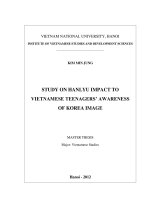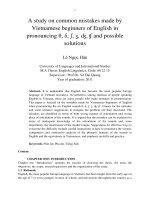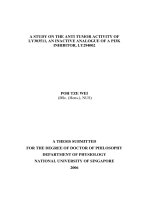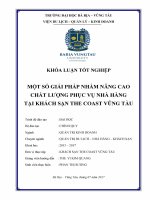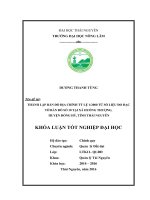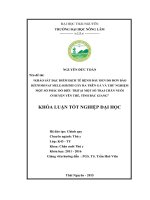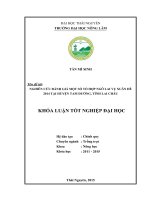Study on the ability to produce extracellular enzymes of lecanicillium lecanii hnl20 and factors affecting the exo enzymatic activity (khóa luận tốt nghiệp)
Bạn đang xem bản rút gọn của tài liệu. Xem và tải ngay bản đầy đủ của tài liệu tại đây (2.88 MB, 68 trang )
VIETNAM NATIONAL UNIVERSITY OF AGRICULTURE
FACULTY OF BIOTECHNOLOGY
-------oOo-------
GRADUATION THESIS
STUDY ON THE ABILITY TO PRODUCE
EXTRACELLULAR ENZYMES OF LECANICILLIUM
LECANII HNL20 AND FACTORS AFFECTING
THE EXO-ENZYMATIC ACTIVITY
Student
: Pham Manh Hung
Department
: Microbial Biotechnology
Supervisor
: Vu Van Hanh, Assoc. Prof
: Nguyen Van Giang, Assoc. Prof
HANOI, 01/2021
COMMITMENT
I with this, declare that all the data and results that I have provided in this study
are true, accurate, and not used in any other reports.
I also assure that the literature cited in the thesis indicated the origin and all
help is thankful.
Hanoi, January 2021
Pham Manh Hung
i
ACKNOWLEGDEMENT
It is with great pride that I hereby present my graduation thesis. During this
six- month long process, I have gained a lot of knowledge of this research and it has
been beneficial to my development in furthering my career and my studies in the
future.
First and foremost, I would like to express absolute gratitude to teachers in
the Faculty of Biotechnology and also the Department of Microbial Biology who
have given me advantageous and valuable knowledge during time learning,
practising and thesis. I had a lot of chances to develop professionally my skills in
both academical and social environment.
I would like to express my appreciation to Dr. Nguyen Van Giang – Lecturer
in the Faculty of Biotechnology. He not only has oriented themes, dedicated guide
throughout the process of the thesis but also given me the in-time supporting to help
me get many chances in my future career.
I sincerely thank the staffs in the Functional Bio-compounds Laboratory,
Institute of Biotechnology, Vietnam Academy of Science and Technology for
helping and providing the most favorable conditions for me during my thesis.
Especially, I extend my gratitude to Dr. Vu Van Hanh – Head of Functional Biocompounds Laboratory for his valuable guidance and support on completion of this
thesis.
Finally, I would like to express profound thanks to my family and numerous
friends who endured this long process with me, always offering support and love
during the process of learning and research.
Thank you. Sincerely!
ii
CONTENTS
COMMITMENT ..................................................................................................... i
ACKNOWLEGDEMENT ..................................................................................... ii
CONTENTS ..........................................................................................................iii
LIST OF TABLES ................................................................................................. v
LIST OF FIGURES............................................................................................... ix
ABBREVIATION LIST .....................................................................................xiii
ABSTRACT ........................................................................................................ xiv
TÓM TẮT ............................................................................................................ xv
PART I: INTRODUCTION ................................................................................... 1
1.1. Introduction................................................................................................... 1
1.2. Purposes .......................................................................................................... 2
1.3. Requirements................................................................................................... 2
PART II. LITERATURE REVIEW....................................................................... 3
2.1. Overview of Lecanicillium lecanii ............................................................... 3
2.1.1. Introduction ................................................................................................ 3
2.1.2. Morphology characteristics of L. lecanii ................................................... 3
2.1.3. Life cycle of L. lecanii ............................................................................... 4
2.1.4. Geographical distribution of L. lecanii ...................................................... 5
2.2. Application of L. lecanii ............................................................................... 6
2.2.1. Myzus persicae ........................................................................................... 6
2.2.2. Aphis gossypii ............................................................................................ 7
2.3. Bioactive compounds.................................................................................... 9
2.3.1. Chitinase..................................................................................................... 9
2.3.2. Protease .................................................................................................... 10
PART III: MATERIALS AND METHODS ....................................................... 11
3.1. Materials and equipment ............................................................................... 11
iii
3.1.1. Materials ..................................................................................................... 11
3.1.2. Equipment .................................................................................................. 11
3.1.3. Chemicals ................................................................................................... 12
3.1.4. Medium ...................................................................................................... 13
3.1.5. Location and time:...................................................................................... 13
3.2. Research methods.......................................................................................... 13
3.2.1. Screening the morphology, the density of conidia and studying on
the activity of extracellular enzymes of HNL20 ...................................... 13
3.2.2. Studying on the elements affecting to the activity of L. lecanii
HNL20 extracellular ................................................................................ 14
3.2.3. Determination the activity of chitinase through spectrophotometry. ........ 17
3.2.4. Determination the activity of cellulase through spectrophotometry. ......... 19
3.2.5. Determination the activity of protease through spectrophotometry. ......... 21
PART IV: RESULTS ........................................................................................... 23
4.1. Evaluating effects (Carbon sources, nitrogen sources, metals ion,
pH, temperature and petroleum oil) affect to the activity of
exoenzymes .............................................................................................. 23
4.1.1. The morphology of hyphae, conidia and the exoenzyme activity of
L. lecanii HNL20. .................................................................................... 23
4.1.2. The results of testing exoenzyme’s activity of L. lecanii HNL20
cultured in PDB medium and PDB medium added Carbon sources
(2% (w/v) molasses, 2% (w/v) glucose and 2% (w/v) sucrose). ............. 25
4.1.3. The results of testing exoenzyme’s activity of L. lecanii HNL20
cultured in PDB medium and PDB medium added yeast extract. ........... 27
4.1.4. The results of testing exoenzyme’s activity of L. lecanii HNL20
cultured in PDB medium and PDB medium added (NH4)2SO4. ............. 29
4.1.5. The results of testing exoenzyme’s activity of L. lecanii HNL20
cultured in PDB medium and PDB medium added Urea. ....................... 31
iv
4.1.6. The effects of temperature (50oC, 60oC, 70oC and 80oC) to the
activity of L. lecanii HLN20 crude enzyme. ........................................... 32
4.1.7. The effects of pH (pH=3,4,5,5,7 and 8) to the activity of L. lecanii
HLN20 crude enzyme. ............................................................................. 35
4.1.8. The effects of petroleum oil (SK Enspray 99EC) at 0.2% (v/v) to
the activity of L. lecanii HLN20 crude enzyme. ..................................... 36
4.1.9. The effects of metal ion (K+, Na+, Ca2+, Mg2+, Zn2+ and Cu2+) to
the activity of L. lecanii HLN20 crude enzyme. ..................................... 37
4.2. The results of testing exoenzyme’s activity of L. lecanii HNL20
cultured in improved medium. ................................................................. 44
4.2.1. Determination the activity of extracellular enzymes through agar
plate diffusion .......................................................................................... 44
4.2.2. Determination the activity of extracellular enzymes through
spectrophotometry.................................................................................... 45
V. CONCLUSSIONS AND SUGGESTTIONS .................................................. 46
5.1. Conclusions ................................................................................................... 47
5.2. Suggestions.................................................................................................... 47
REFERENCES ..................................................................................................... 47
APPENDIXES ..................................................................................................... 51
v
LIST OF TABLES
Table 3.1: The instruments and equipment were used in the research ................... 11
Table 3.2: Chemicals were used in the research ..................................................... 12
Table 3.3:The standard curve of D-glucosamine .................................................... 18
Table 3.4: The standard curve of glucose ............................................................... 20
Table 3.5: The standard curve of tyrosine............................................................... 21
Table 3.6: The processes of determining the protease activity ............................... 22
Table 3.7: The processes of spectrophotometric reaction ....................................... 22
Table 4.1: The results of degradation round of L. lecanii HNL20
extracellular enzymes cultured in PDB medium after 5, 6,7 and 8
days (pH=6, 28oC, shaking 150rpm) on substrates: (A) 0.1% (w/v)
CMC, (B) 0.1% (w/v) chitosan and (C) 0.2% (w/v) casein........................ 24
Table 4.2: The density of L. lecanii HNL20’s conidia cultured in PDB
medium after 5, 6,7 and 8 days (pH=6, 28oC, shaking 150rpm) ................ 24
Table 4.3: The results of degradation round of L. lecanii HNL20
extracellular enzymes cultured in PDB medium and PDB medium
added respectively Carbon sources: 2% (w/v) molasses, 2% (w/v)
glucose and 2% (w/v) sucrose (at pH=6, 28oC, shaking 150rpm)
on substrates: (A) 0.1% (w/v) CMC, (B) 0.1% (w/v) chitosan and
(C) 0.2% (w/v) casein. ................................................................................ 26
Table 4.4: The results of degradation round of L. lecanii HNL20
extracellular enzymes cultured in PDB medium and PDB medium
added
respectively
Carbon
sources:
(yeast
extract)
at
concentrations: 0.25% (w/v), 0.5% (w/v), 0.75% (w/v), 1% (w/v),
1.25% (w/v) and 1.5% (w/v) (at pH=6, 28oC, shaking 150rpm) on
substrates: (A) 0.1% (w/v) CMC, (B) 0.1% (w/v) chitosan and (C)
0.2% (w/v) casein........................................................................................ 28
vi
Table 4.5: The results of degradation round of L. lecanii HNL20
extracellular enzymes cultured in PDB medium and PDB medium
added
respectively
Nitrogen
sources:
(NH4)2SO4
at
concentrations: 0.25% (w/v), 0.5% (w/v), 0.75% (w/v), 1% (w/v),
1.25% (w/v) and 1.5% (w/v) (at pH=6, 28oC, shaking 150rpm) on
substrates: (A) 0.1% (w/v) CMC, (B) 0.1% (w/v) chitosan and (C)
0.2% (w/v) casein........................................................................................ 30
Table 4.6: The results of degradation round of L. lecanii HNL20
extracellular enzymes cultured in PDB medium and PDB medium
added respectively Nitrogen sources: Urea at concentrations:
0.25% (w/v), 0.5% (w/v), 0.75% (w/v), 1% (w/v), 1.25% (w/v)
and 1.5% (w/v) (at pH=6, 28oC, shaking 150rpm) on substrates:
(A) 0.1% (w/v) CMC, (B) 0.1% (w/v) chitosan and (C) 0.2%
(w/v) casein. ................................................................................................ 32
Table 4.7: The results of degradation round of L. lecanii HNL20’s
exoenzymes after testing at 50oC, 60oC, 70oC and 80oC in 10
minutes on substrates: (A) 0.1% (w/v) CMC, (B) 0.1% (w/v)
chitosan and (C) 0.2% (w/v) casein. ........................................................... 33
Table 4.8: The results of degradation round of L. lecanii HNL20’s
exoenzymes after testing at pH=3,4,5,5,7 and 8 on substrates: (A)
0.1% (w/v) CMC, (B) 0.1% (w/v) chitosan and (C) 0.2% (w/v)
casein ........................................................................................................... 36
Table 4.9: The results of degradation round of L. lecanii HNL20’s
exoenzymes after incubating with 0.2% (v/v) petroleum oil on
substrates: (A) 0.1% (w/v) CMC, (B) 0.1% (w/v) chitosan and (C)
0.2% (w/v) casein........................................................................................ 37
Table 4.10: The results of degradation round of L. lecanii HNL20’s
exoenzymes after incubating respectively with Na+at 5mM, 10mM
vii
and 15mM on substrates: (A) 0.1% (w/v) CMC, (B) 0.1% (w/v)
chitosan and (C) 0.2% (w/v) casein. ........................................................... 38
Table 4.11: The results of degradation round of L. lecanii HNL20’s
exoenzymes after incubating respectively with K+at 5mM, 10mM
and 15mM on substrates: (A) 0.1% (w/v) CMC, (B) 0.1% (w/v)
chitosan and (C) 0.2% (w/v) casein. ........................................................... 39
Table 4.12: The results of degradation round of L. lecanii HNL20’s
exoenzymes after incubating
respectively with Ca2+ at 5mM,
10mM and 15mM on substrates: (A) 0.1% (w/v) CMC, (B) 0.1%
(w/v) chitosan and (C) 0.2% (w/v) casein. ................................................. 40
Table 4.13: The results of degradation round of L. lecanii HNL20’s
exoenzymes after incubating respectively with Mg2+ at 5mM,
10mM and 15mM on substrates: (A) 0.1% (w/v) CMC, (B) 0.1%
(w/v) chitosan and (C) 0.2% (w/v) casein. ................................................. 41
Table 4.14: The results of degradation round of L. lecanii HNL20’s
exoenzymes after incubating respectively with Zn2+ at 5mM,
10mM and 15mM on substrates: (A) 0.1% (w/v) CMC, (B) 0.1%
(w/v) chitosan and (C) 0.2% (w/v) casein. ................................................. 42
Table 4.15: The results of degradation round of L. lecanii HNL20’s
exoenzymes after incubating respectively with Cu2+ at 5mM,
10mM and 15mM on substrates: (A) 0.1% (w/v) CMC, (B) 0.1%
(w/v) chitosan and (C) 0.2% (w/v) casein. ................................................. 43
Table 4.17: The results of degradation round of L. lecanii HNL20’s
exoenzymes after culturing 6 days in improved medium at pH=6,
28oC, shaking 150rpm on substrates: (A) 0.1% (w/v) CMC, (B)
0.1% (w/v) chitosan and (C) 0.2% (w/v) casein. ........................................ 44
Table 4.18: OD values and activity of extracellular enzymes cultured in
improved medium through spectrophotometry .......................................... 45
viii
LIST OF FIGURES
Figure 2.1: Activating L. leacnii HNL20 on PDA medium after 6 days at
28oC and shaking 15rpm ............................................................................... 3
Figure 2.2: Conidiophores and conidia of L. lecanii (Rasoul Zare &
Gams, 2001) .................................................................................................. 4
Figure 2.3: Dead insects caused by L. lecanii ........................................................... 4
Figure 2.4: The distribution of L. lecanii in the world (According to
website: accessed at
8:46 AM (GMT+7), Jan 12th2021. ................................................................ 5
Figure 2.5: The nymphs (left) and adults (right) of Myzus persicae.
Photograph by Lyle J. Buss, University of Florida. ..................................... 6
Figure 2.6: The nymphs and adults of Aphis gossypii ............................................. 8
Figure 2.7: The structures of chitin and chitosan (Younes & Rinaudo,
2015) ............................................................................................................. 9
Figure 4.1: The morphology of L. lecanii HL20 hyphae after culturing 5,
6, 7, 8 days in PDB medium at PH=6, 28oC and shaking 150rpm. ............ 23
Figure 4.2: The degradation round of exoenzymes after culturing 5, 6,7
and 8 days (in PDB medium at pH=6, 28oC, shaking 150rpm) on
substrates: (A) 0.1% (w/v) CMC, (B) 0.1% (w/v) chitosan and (C)
0.2% (w/v) casein........................................................................................ 24
Figure 4.3: The degradation round of L. lecanii HNL20’s exoenzymes
after culturing 6 days in PDB medium and PDB medium added
respectively Carbon sources: 2% (w/v) molasses, 2% (w/v)
glucose and 2% (w/v) sucrose (at pH=6, 28oC, shaking 150rpm)
on substrates: (A) 0.1% (w/v) CMC, (B) 0.1% (w/v) chitosan and
(C) 0.2% (w/v) casein. ................................................................................ 25
Figure 4.4: The degradation round of L. lecanii HNL20’s exoenzymes
after culturing 6 days in PDB medium and PDB medium added
respectively Nitrogen sources (yeast extract) at concentrations:
ix
0.25% (w/v), 0.5% (w/v), 0.75% (w/v), 1% (w/v), 1.25% (w/v)
and 1.5% (w/v) (at pH=6, 28oC, shaking 150rpm) on substrates:
(A) 0.1% (w/v) CMC, (B) 0.1% (w/v) chitosan and (C) 0.2%
(w/v) casein. ................................................................................................ 27
Figure 4.5: The degradation round of L. lecanii HNL20’s exoenzymes
after culturing 6 days in PDB medium and PDB medium added
respectively Nitrogen sources (NH4)2SO4 at concentrations: 0.25%
(w/v), 0.5% (w/v), 0.75% (w/v), 1% (w/v), 1.25% (w/v) and 1.5%
(w/v) (at pH=6, 28oC, shaking 150rpm) on substrates: (A) 0.1%
(w/v) CMC, (B) 0.1% (w/v) chitosan and (C) 0.2% (w/v) casein. ............. 29
Figure 4.6: The degradation round of L. lecanii HNL20’s exoenzymes
after culturing 6 days in PDB medium and PDB medium added
respectively Nitrogen sources (Urea) at concentrations: 0.25%
(w/v), 0.5% (w/v), 0.75% (w/v), 1% (w/v), 1.25% (w/v) and 1.5%
(w/v) (at pH=6, 28oC, shaking 150rpm) on substrates: (A) 0.1%
(w/v) CMC, (B) 0.1% (w/v) chitosan and (C) 0.2% (w/v) casein. ............. 31
Figure 4.7: The degradation round of L. lecanii HNL20’s exoenzymes
after testing at 50oC, 60oC, 70oC and 80oC in 10 minutes on
substrates: (A) 0.1% (w/v) CMC, (B) 0.1% (w/v) chitosan and (C)
0.2% (w/v) casein........................................................................................ 33
Figure 4.8: The degradation round of L. lecanii HNL20’s exoenzymes
after testing at pH=3,4,5,5,7 and 8 on substrates: (A) 0.1% (w/v)
CMC, (B) 0.1% (w/v) chitosan and (C) 0.2% (w/v) casein........................ 35
Figure 4.9: The degradation round of L. lecanii HNL20’s exoenzymes
after incubating with 0.2% (v/v) petroleum oil on substrates: (A)
0.1% (w/v) CMC, (B) 0.1% (w/v) chitosan and (C) 0.2% (w/v)
casein ........................................................................................................... 36
Figure 4.10: The degradation round of L. lecanii HNL20’s exoenzymes
after incubating respectively with Na+at 5mM, 10mM and 15mM
x
on substrates: (A) 0.1% (w/v) CMC, (B) 0.1% (w/v) chitosan and
(C) 0.2% (w/v) casein. ................................................................................ 37
Figure 4.11: The degradation round of L. lecanii HNL20’s exoenzymes
after incubating respectively with K+at 5mM, 10mM and 15mM
on substrates: (A) 0.1% (w/v) CMC, (B) 0.1% (w/v) chitosan and
(C) 0.2% (w/v) casein. ................................................................................ 38
Figure 4.12: The degradation round of L. lecanii HNL20’s exoenzymes
after incubating respectively with Ca2+ at 5mM, 10mM and 15mM
on substrates: (A) 0.1% (w/v) CMC, (B) 0.1% (w/v) chitosan and
(C) 0.2% (w/v) casein. ................................................................................ 39
Figure 4.13: The degradation round of L. lecanii HNL20’s exoenzymes
after incubating respectively with Mg2+ at 5mM, 10mM and
15mM on substrates: (A) 0.1% (w/v) CMC, (B) 0.1% (w/v)
chitosan and (C) 0.2% (w/v) casein. ........................................................... 40
Figure 4.14: The degradation round of HNL20’s exoenzymes after
incubating respectively with Zn2+ at 5mM, 10mM and 15mM on
substrates: (A) 0.1% (w/v) CMC, (B) 0.1% (w/v) chitosan and (C)
0.2% (w/v) casein........................................................................................ 41
Figure 4.15: The degradation round of L. lecanii HNL20’s exoenzymes
after incubating respectively with Cu2+ at 5mM, 10mM and 15mM
on substrates: (A) 0.1% (w/v) CMC, (B) 0.1% (w/v) chitosan and
(C) 0.2% (w/v) casein. ................................................................................ 42
Figure 4.16: The degradation round of L. lecanii HNL20’s exoenzymes
after culturing 6 days in improved medium at pH=6, 28oC,
shaking 150rpm on substrates: (A) 0.1% (w/v) CMC, (B) 0.1%
(w/v) chitosan and (C) 0.2% (w/v) casein. ................................................. 44
xi
LIST OF GRAPHS
Graph 1: The degradation round of L. lecanii HNL20’s exoenzymes after
testing at 50oC, 60oC, 70oC and 80oC in 10 minutes on substrates:
(A) 0.1% (w/v) CMC, (B) 0.1% (w/v) chitosan and (C) 0.2%
(w/v) casein. ............................................................................................. 34
Graph 2: The degradation round of L. lecanii HNL20’s exoenzymes after
culturing 6 days in improved medium at pH=6, 28oC, shaking
150rpm on substrates: (A) 0.1% (w/v) CMC, (B) 0.1% (w/v)
chitosan and (C) 0.2% (w/v) casein. ........................................................ 45
Graph 3: The tyrosine standard curve .................................................................. 51
Graph 4: The glucose standard curve ................................................................... 51
Graph 3: The D-glucosamine standard curve ...................................................... 52
xii
ABBREVIATION LIST
L. lecanii
Lecanicillium lecanii
PDA
Potato Dextrose Agar
PDB
Potato dextrose agar
CMC
Carboxymethyl cellulose
TCA
Trichloroacetic acid
OD
Optical density
DNS
3,5-Dinitrosalicylic acid
w/w
Weight/weight
w/v
Weight/volume
xiii
ABSTRACT
Lecanicillium lecanii HNL20 was cultured in PDB medium and to determine
the ability to produce extracellular enzymes (cellulase, protease and chitinase) and
screened the morphology of hyphae and conidia. The activity of extracellular
enzymes was determined to depend on the development of hyphae and density of
conidia.
Based on the study of effecting factors, two improved environments were
established to check the enhancement of elements to the activity of extracellular
enzymes. The components of Medium 1 are potato 200g; Glucose 20g; 1 liter of
water; 2% (w/v) molasses; 1% (w/v) yeast extract; 1.5% (w/v) (NH 4)2SO4; 0.25%
(w/v) Urea; KH2PO4 10mM and MgSO4 10mM.The components of Medium 2 are
potato 200g; Glucose 20g; 1 liter of water; 0.02% (w/v) MgSO 4; 0.02% (w/v)
KH2PO4 and 0.01% (w/v) NH4NO3.
Through spectrophotometry, the activity of cellulase, chitinase and protease
was recorded respectively to be 70.3 U/ml, 0.057 U/ml and 0.237 U/ml for Medium
1. In terms of medium 2, the results were observed to be 57.488 U/ml, 0.034 U/ml
and 0.139 U/ml, in that order.
xiv
TĨM TẮT
Chủng Lecanicillium lecanii HNL20 được ni cấy trong mơi trường PDB để
xác định khả năng sản sinh các enzyme ngoại bào (cellulase, protease and chitinase)
và quan sát hình thái của hệ sợi và bào tử. Theo đó, hoạt độ của các enzyme này
phụ thuộc vào sự phát triển của hệ sợi và mật độ của bào tử.
Dựa vào sự nghiên cứu các yếu tố ảnh hưởng, hai môi trường cải tiến được tạo
ra để kiểm tra các yếu tố giúp tăng hoạt tính của các enzyme ngoại bào. Thành phần
môi trường 1 bao gồm khoai tây 200g; Glucose 20g; 1 lít nước; 2% (w/v) rỉ mật;
1% (w/v) cao nấm men; 1.5% (w/v) (NH4)2SO4; 0.25% (w/v) Urê; KH2PO4 10mM
và MgSO4 10mM. Thành phần môi trường 2 bao gồm khoai tây 200g; Glucose 20g;
1 lít nước; 0.02% (w/v) MgSO4; 0.02% (w/v) KH2PO4 và 0.01% (w/v) NH4NO3.
Thông qua phép đo quang phổ hấp thụ, hoạt tính của các enzyme cellulase,
chitinase và protease được ghi lại lần lượt là 70,3 U/ml, 0,057 U/ml và 0,237 U/ml
đối với môi trường 1. Đối với môi trường 2, kết quả được quan sát theo thứ tự là
57,488 U/ml, 0,034 U/ml và 0,139 U/ml.
xv
PART I: INTRODUCTION
1.1.
Introduction
Agriculture is known as a sector contributed greatly to the development of
world economy; however, agricultural activities impact negatively to environment,
specially overuse of chemical pesticide. Overuse of chemical pesticide affects to
human health, damages balance of ecosystem and causes pollution of natural
environment such as water, air and land. Thus, people are finding environmentally
friendly methods to solve this problem but still ensure the protection of crops.
Lecanicillium lecanii (former Verticillium lecanii) is an entomopathogenic
fungus considered as a potential solution to alternative the use of chemical
pesticides. L. lecanii is used widely as a biocontrol agent with large range of insect
hosts such Homoptera, Coleoptera, Orthoptera and Lepidopthera (Xu, Yu, & Shi,
2011). It has been studied to produce extracellular enzymes such as protease,
chitinase and cellulase in culture medium (St Leger., Raymond., Cooper., &
Richard., 1986), (Cristina Petrisor. & Stoian., 2017). These enzymes are able to
break down the defense of hosts in order to penetrate into body, form spores and kill
them. L. lecanii is applied to control and prevent crops from pests which help to
enhance the yield of crops without affecting to environment (Ravindran et al.,
2018), (Hanan, Basit, Nazir, Majeed, & Qiu, 2020).
Viet Nam is currently on the direction to develop green agriculture with
desiring to export agricultural products to potential markets such as Europe and the
US. These countries have rigid standards in terms of the quality of imported
products, especially the residue of pesticide. Therefore, the area of farming
according to Good Agricultural Practices (GAP) standards and organic standards
are increasing rapidly. To produce agricultural products that meet these standards,
the use of organic fertilizer and biological pesticides is required. However,
according to the report provided by National Agency for Science and Technology
Information (Le Xuan Dinh & Dang Bao Ha, 2015), the number of domestic
biopesticides only made up about 37.3 % total used pesticides. This figure shows
1
that Vietnam is lack of technique and researches about the production and
application of biopesticides. Due to that, to determine bio- compounds in fungi and
enhance the activity of these compounds to form biopesticides, we conduct: “Study
on the ability to produce extracellular enzymes of entomopathogenic fungus
Lecanicillium lecanii HNL20”.
1.2. Purposes
- Studying on producing extracellular enzymes of Lecanicillium lecanii
HNL20.
- Evaluating effects to the activity of exoenzymes of HNL20.
- Creeating the optimum medium to culture Lecanicillium lecanii HNL20
1.3. Requirements
- Determining the ability to produce extracellular enzymes of L. lecanii
HNL20.
- Evaluating elements (Carbon sources, nitrogen sources, metals ion, pH,
temperature and petroleum oil) affect to the activity of extracellular enzymes
produced by Lecanicillium lecanii HNL20.
- Building optimized medium for enhancing and determining exactly the
activity of extracellular enzymes
2
PART II. LITERATURE REVIEW
2.1.
Overview of Lecanicillium lecanii
2.1.1. Introduction
Lecanicillium lecanii is an entomopathogenic fungus species which belong to
division
Ascomycota,
class
Sordariomycetes,
order
Hypocreales,
family
Cordycipitaceae. In the past, Lecanicillium lecanii was formerly known as Verticillium
lecanii (Zimmerman) Viegas). However, based on recently using rDNA sequencing, the
genus Verticillium was placed to new genus Lecanicillium (R. Zare & Games, 2003),
(Rasoul Zare & Gams, 2001). The members of genus Lecanicillium consists of L.
attenuatum, L. lecanii, L. longisporum, L. muscarium or L. nodulosum.
Lecanicillium lecanii has the ability to against a number of pests such as
Homoptera, Coleoptera, Orthoptera and Lepidopthera (Xu et al., 2011). The
mechanism of L. lecanii is acting as microparasites, attaching to the body of hosts.
After that, conidia develop to form hyphae producing enzymes such as chitinase and
protease that allow penetration of hyphae then kill pathogens. In relevant
conditions, conidia are produced outside of dead pathogen and spread to others.
Depending on working as natural pesticides, researches of L. lecanii direct to
form biopesticides from conidia of L. lecanii and study on mechanisms of enzymes
(chitinase, protease, cellulase and lipase) or toxic compounds produced by this fungus.
2.1.2. Morphology characteristics of L. lecanii
Figure 2.1: Activating L. leacnii HNL20 on PDA medium after 6 days at 28oC and
shaking 15rpm
3
Colonies reaching 15–25 mm in 10 days at 24°C on PDA, rather compact,
yellowish-white with reverse deep yellow. Conidiogenous cells phialides, relatively
short, 1120(30) ì 1.41.8 àm, aculeate and strongly tapering, produced singly or
in whorls of up to 6 directly on prostrate hyphae, or on short, erect conidiophores,
sometimes also produced secondarily on previous phialides.
Figure 1.2: Conidiophores and conidia of L. lecanii (Rasoul Zare & Gams, 2001)
Conidia formed in heads at apex of phialides, typically short-ellipsoidal, 2.53.5(4.2) ì
11.5 àm, homogeneous in size and shape. Crystals present, octahedral. Growth
temperature optimum 21–24°C, no growth at 33°C (Rasoul Zare & Gams, 2001).
2.1.3. Life cycle of L. lecanii
Figure 2.2: Dead insects caused by L. lecanii (According to website:
accessed at
8:40 AM (GMT+7), Jan 12th2021)
4
The life cycle of L. lecanii begins with conidia form and adhering to the
protective outer layer of the insect (epicuticle): While on this outer protective layer,
the conidia starts germinating and forming elongated germ tubes capable of
penetrating the hard layer. This is made possible by the secretion of enzymes
(aminopeptidase lipase, proteases, Esterase, chitinases and cellulase) that enhance
the lysis of the epicuticle making it possible for the germ to easily penetrate the
covering and continue growing in the host insect.
Hyphal growth of L. lecanii causes the death of insects through the pressure as
well as the secreted enzymes. Nutrients from insects are used for the development
of hyphae which finally differentiates to conidiophores on the surface of the insect
that produce conidia. The landing of conidia allows L. lecanii to begin the new life
cycle on the epicuticle of another host insect. Until now, there is no clear evidence
for determining the effects of L. lecanii toxicity to humans.
2.1.4. Geographical distribution of L. lecanii
Figure 2.3: The distribution of L. lecanii in the world (According to website:
accessed at 8:46 AM (GMT+7), Jan
12th2021.
According to the geographical distribution map of L. lecanii (Figure 4), L. lecanii
distributes largely over the world in the vast majority of continents such as Asia,
Americas. However, due to high-temperature climate, Africa is one of the areas
which L. lecanii not exist. In addition to this, although Vietnam belongs to Asia,
5
from the above data, there is no distribution of L. lecanii in Vietnam. The reason is
that Vietnam is a tropical climate with high temperature and humidity so L. lecanii
maybe not capable of growing naturally in the environment.
2.2.
Application of L. lecanii
2.2.1. Myzus persicae
Myzus persicae (the green peach aphid or greenfly) belongs to family
Aphididae that is a small green aphid. This insect causes the decrease of growth,
shrivelling of the leaves and the death of various tissues. In addition to this, Myzus
persicae is recognized as a vector for the transmission of viruses to plants such as
cucumber mosaic virus (CMV), potato virus Y (PVY) and tobacco etch virus
(TEV) (Gadhave, Gautam, Rasmussen, & Srinivasan, 2020). Host plants of aphid
variously include cabbage and related cole crops, dandelion, endive, mustard
greens, parsley, turnip, tomato, cucumber, tobacco, potato, spinach, pepper, beet,
celery, lettuce, and chard.
The presence of cold winter is a factor which decides the life cycle of Myzus
persicae (van Emden, Eastop, Hughes, & Way, 1969). The ability of development
is extremely rapid and it takes about 10-12 days completing a new generation. For
unsuitable host plants, the aphid attacks on Prunus spp in the egg stage. When the
spring starts, soon after the plants begin to grow, the eggs hatch and use flowers,
young foliage and stems as food. After the spring, winged insects move and send
nymphs on summer host and the adults will develop and mate in the winter.
Figure 2.4: The nymphs (left) and adults (right) of Myzus persicae. Photograph by
Lyle J. Buss, University of Florida. Website:
accessed at
8:47 AM (GMT+7), Jan 12th2021.
6
Symptoms
Myzus persicae concentrates on young plant tissues and causes water stress,
wilting, and reduced growth rate of the plant. Prolonged aphid infestation can cause
appreciable reduction in yield of root crops and foliage crops. Furthermore, the
more important damage of green peach aphid is a vector of transmission viruses.
Some of the particularly damaging diseases include potato leafroll virus and potato
virus Y to Solanaceae, beet western yellows and beet yellows viruses to
Chenopodiaceae, lettuce mosaic virus to Compositae, cauliflower mosaic and turnip
mosaic viruses to Cruciferae, and cucumber mosaic and watermelon mosaic viruses
to Cucurbitaceae. A discoloration in potato tubers, called net necrosis, occurs in
some potato varieties following transmission of potato leafroll.
Controlled by L.lecanii
The solutions containing the conidia of L.lecanii are procedured and sprayed
directly in order to kill adults or prevent the development of nymphs. L.lecanii (V.
lecanii) causes the death of Myzus persicae at high mortality in cucumber as hosts
(Abbas & Mohammed, 2019).
2.2.2. Aphis gossypii
Aphis gossypii is known as cotton aphid, melon aphid or cotton and melon
aphid. This aphid has a tiny size located in superfamily Aphidoidea in the order
Hemiptera. The main plants affected by Aphis gossypii belong to the families
Cucurbitaceae, Rutaceae and Malvaceae such as watermelons, cucumbers,
cantaloupes, squash and pumpkin. Citrus, cotton and hibiscus are also affected by
cotton aphid.
The adult body is about 2 mm in length. The head and thorax of the pearshaped alate adult are black. The color of the body is variable, yellow-green to dark
green, sometimes almost black, with its siphuncle, cauda and the apical part of the
antennae and rostrum brown or dusky. The apterate adult is of variable color too.
7
There is an elongated dark spot on each of the forewings. The body color of the
nymphs varies from very pale yellow to pale green and they are smaller than the
adults.
Figure 2.5: The nymphs and adults of Aphis gossypii (According to website:
accessed at 8:47 AM
(GMT+7), Jan 12th2021.
Symptoms
The first symptom of Aphis gossypii is yellow leaves. As many as aphids,
leaves become to puckered, and curled. After reaching high populations, cotton
aphids move to young leaves, flowers and stems. Plants are covered with a black
sooty mould grows on secreted honeydew of aphids. Finally, plants are twisted and
killed by Aphis gossypii.
Controlled by L.lecanii
The solutions containing the conidia of L.lecanii are procedured and sprayed
directly in order to kill adults or prevent the development of nymphs. The ability of
killing Aphis gossypii was determined to be effective (Hall, 1982).
Moreover, L.lecanii is also researched to control other pests like white fly
(Hall, 1982), cereal aphids (Aqueel & Leather, 2013). Besides, optimizing culture
medium and extracting biocompounds from L.lecanii are also specially focused
such as (Shi, Xu, & Zhu, 2009), (Yu et al., 2015). In Vietnam, researchers are really
interested in the applications of entomopathogenic fungi, especially L.lecanii. The
8
process of purifying
chitinase from L. lecanii strain 43H was conducted by
(Nguyen, Quyen, Nguyen, & Vu, 2015). (Vũ Văn Hạnh, 2012) improved the
virulence and toxicity of L.lecanii through mutations caused by UV and N-methylN’-nitro-N-nitrosoguanidine.
2.3.
Bioactive compounds
2.3.1. Chitinase
Figure 2.6: The structures of chitin and chitosan (Younes & Rinaudo, 2015)
Chitin is a linear of monomers β-1, 4-N-acetylglucosamine (GlcNAC) which
is widely known as the second most popular on Earth. Chitin is the main component
of the outer skeleton in insects, fungi, yeasts, algae, crabs, shrimps, and lobsters,
also in internal structures of other invertebrates. Dry chitin is white, hard and
unsolvable in water. While chitosan is a polysaccharide consisted of randomly
distributed β-(1→4)-linked D-glucosamine (deacetylated unit) and N-acetyl-Dglucosamine (acetylated unit). Chitosan is made by deacetylating chitin (shrimp
shells) with an alkaline hydroxide. The degree of deacetylated unit and N-acetyl-Dglucosamine can be determined by Nuclear magnetic resonance spectroscopy (NMR
spectroscopy). Both chitin and chitosan are able to be degraded by chitinase.
Chitinases (chitodextrinase, 1,4-beta-poly-N-acetylglucosaminidase, polybeta-glucosaminidase, beta-1,4-poly-N-acetyl glucosamidinase, poly[1,4-(N-acetylbeta-D-glucosaminide)] glycanohydrolase, (1->4)-2-acetamido-2-deoxy-beta-Dglucan glycanohydrolase) are glycosyl hydrolases with the sizes ranging from 20
kDa to about 90 kDa. Based on amino acid sequences and domain architectures,
chitinase enzymes are divided into glycosyl hydrolase family 18, 19, 20. Families
9
